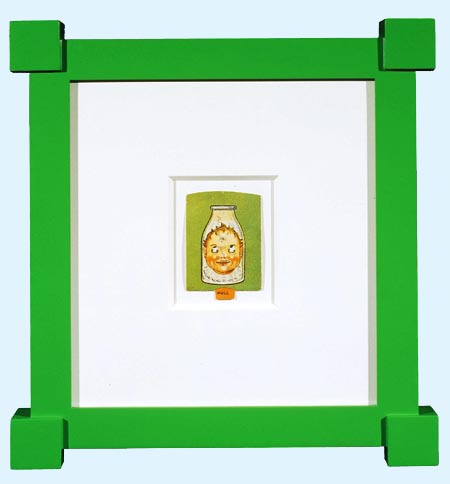


Baby-in-a-Bottle Pull Toy, ca. 1963
Readmade toy, 4 3/8 x 3 inches
590 bis. Baby in a Bottle Pull Toy ca. 1963, New York
Signed diagonally across surface: Marcel Duchamp
This work is heretofore unknown in the literature on Marcel Duchamp (it does not appear in any editions of the catalogue raisonné by Arturo Schwarz). It was recently discovered in the New York art market, but came originally from the collection of Vincent Romano.
Romano is an artist who, from 1965 through 1972, worked as a guard at the Museum of Modern Art in New York. His art work was Fluxus-inspired and, in that vein, he assembled pieces for inclusion his own personal museum of small artifacts that he called the Musée Luini (a wordplay on the name Mussolini), in which he also planned to include ephemera by notable artists. One afternoon he spotted Marcel Duchamp walking through the galleries of the museum. Knowing that Duchamp was the artist who introduced the concept of the readymade, he decided to see if he would sign something for him, a work to be included in his project. Romano always had a few miscellaneous items stuffed into his pockets, things that he worked on during breaks, so he pulled out a small paper toy, a facsimile of a nineteenth- or early-twentieth-century paper fold-out toy that he purchased from Charles Shackman’s (a toy store located in midtown Manhattan). Without providing any explanation, he approach Duchamp and asked him to sign it. “He obliged,” Romano later recalled, “anything to devalue his signature.” 1
It is ironic—but perhaps not altogether inconsistent with his way of thinking—that Duchamp so willingly agreed to sign this object, for this signing raises the question as to whether or not the object should be considered a work of art by him, or by the person who asked him to sign it. Indeed, such questions form the basis upon which the readymade was established. When the concept of the readymade was introduced—and made public with the incident surrounding the Fountain in 1917 (Schwarz cat no. 345)—people naturally questioned whether Duchamp should be allowed to take credit for something designed and created (or, in the case of most readymades, manufactured) by someone else. In this respect, it equally ironic that Duchamp signed a toy, for a half century earlier—in 1910—he inscribed and signed another toy, a wood bilboquet, as a gift for a friend, a work that was excluded from publication in more recent edition of the Schwarz catalogue raisonné.2
No matter how this work is categorized today, Duchamp must have found the object itself quite amusing. When the tab at its base is pulled, the baby in the bottle rolls his eyes and spits out his tongue at the viewer. One might argue that such a gesture represents the ultimate expression of a purely Dada sensibility. Duchamp may have noted that the toy bore an amusing thematic similarity to With My Tongue in My Cheek (cat. no. 571), a work from 1959 featuring a plaster cast of the artist’s cheek which illustrates the idiomatic expression for speaking with intentional irony (“with my tongue in my cheek”). Moreover, because the baby is emblazoned on the surface of a milk bottle, it shares perhaps an even more obvious rapport with the readymade Bottlerack of 1914 (Schwarz cat. no. 306).
1 Email message from Vincent Romano to Francis M. Naumann, December 14, 2004.
2 See Francis M. Naumann, "Duchamp's Erotic Souvenir," Artnews 99, no. 2 (February 2000): 100-01.